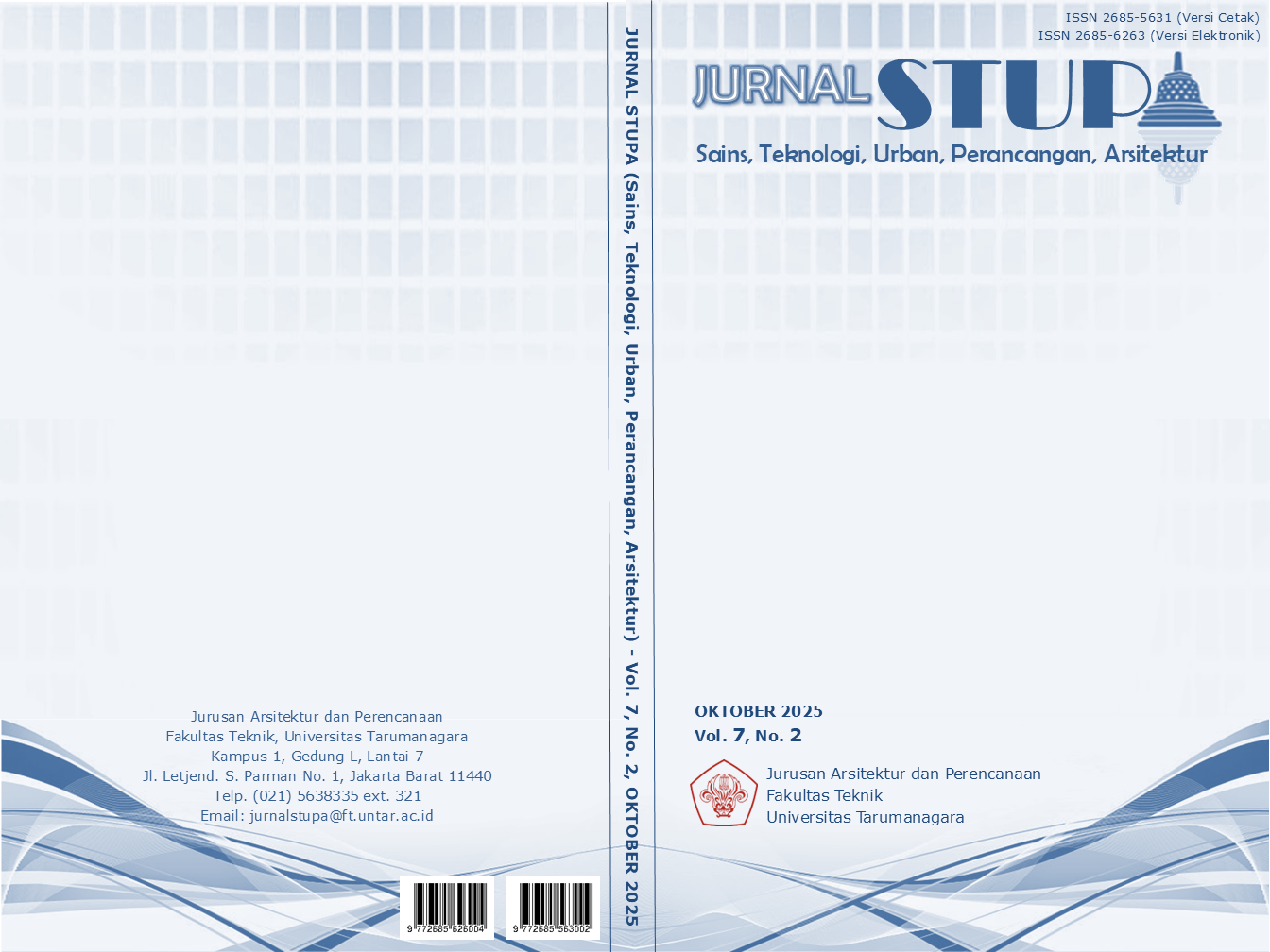RENEWAL: STADION TERBENGKALAI KAMAL MUARA DENGAN PENDEKATAN DESAIN ARSITEKTUR REGENERATIF
Main Article Content
Abstract
Kamal Muara Stadium, which has been a center for sports and social activities since 1980, is now neglected due to physical damage and recurring tidal flooding. This condition hinders the growth of local soccer and eliminates interaction spaces for the community. Regenerating the stadium is important to revive the socio-ecological function of the area and encourage inclusive and sustainable community development. This study employs qualitative methods through field observations, interviews, documentation, and literature reviews. Using a regenerative architecture approach, the research addresses the impacts of tidal flooding that have degraded the stadium’s functions. The design focuses on tidal flood mitigation through ecology-based water retention and control systems, while restoring the stadium’s social role. The steps taken include analyzing existing conditions, mapping problems and potentials, case studies, and community participation. The expected outcome is the regeneration of the stadium's functions and capacity into a multifunctional public space capable of restoring the coastal ecosystem, absorbing tidal floodwater, and providing an inclusive and resilient green space against tidal floods, while also serving as a center for social interaction, sports, education, and local ecotourism. A resilient architectural design concept is applied as the primary approach in the project's design. The revitalization of Kamal Muara Stadium offers a comprehensive architectural solution to the social, ecological, and technical challenges faced by Jakarta's coastal areas.
Keywords: Degradation; flooding; regenerative; resilient; stadium
Abstrak
Stadion Kamal Muara yang sejak 1980 menjadi pusat aktivitas olahraga dan sosial kini terbengkalai akibat kerusakan fisik dan banjir rob yang berulang. Kondisi ini menghambat pertumbuhan sepak bola lokal serta menghilangkan ruang interaksi bagi masyarakat. Regenerasi stadion menjadi penting untuk menghidupkan kembali fungsi sosial-ekologis kawasan serta mendorong pembangunan komunitas yang inklusif dan berkelanjutan. Penelitian ini menggunakan metode kualitatif melalui observasi lapangan, wawancara, dokumentasi, dan metode komparatif untuk mencapai kehidupan dari fungsi sosial ekologis. Pendekatan arsitektur regeneratif digunakan untuk merespons dampak banjir rob dengan menggunakan sistem polder. Perancangan diarahkan pada mitigasi rob melalui sistem penampungan dan pengendalian air berbasis ekologi, sembari mengembalikan peran sosial stadion. Langkah-langkah yang dilakukan mencakup analisis kondisi eksisting, pemetaan masalah dan potensi, studi kasus, serta pelibatan partisipasi masyarakat. Hasil yang diharapkan adalah regenerasi fungsi dan kapasitas stadion mampu menjadi ruang publik multifungsi yang merestorasi ekosistem pesisir, menyerap air rob, serta menyediakan ruang hijau yang inklusif dan tangguh terhadap banjir rob, sekaligus menjadi pusat interaksi sosial, olahraga, edukasi, dan ekowisata lokal. Konsep desain arsitektur resilien diterapkan sebagai pendekatan utama dalam perancangan proyek ini. Revitalisasi Stadion Kamal Muara menawarkan solusi arsitektural yang menyeluruh terhadap permasalahan sosial, ekologis, dan teknis yang dihadapi kawasan pesisir Jakarta.
Article Details

This work is licensed under a Creative Commons Attribution-NonCommercial-ShareAlike 4.0 International License.
This work is licensed under a Jurnal Sains, Teknologi, Urban, Perancangan, Arsitektur/ STUPA Creative Commons Attribution-NonCommercial-ShareAlike 4.0 International LicenseReferences
Afriansyah, Roylani, F., Chania, M., Sudarsih, S., & Fatmawati. (2024). POTENSI PENGEMBANGAN TAMAN KOTA SEBAGAI RUANGTERBUKAHIJAUDI PEKANBARU UNTUK MITIGASI PERUBAHAN IKLIM. Scientia Jurnal Ilmiah Sains dan Teknologi, 815.
Agustin, Z., Azzahro, I. A., Fachrudin, M. A., & Sari, L. B. (2023). Peranan Taman Kota Dalam Mewujudkan Kota Berkelanjutan di Perkotaan Tulungagung. Dewantara : Jurnal Pendidikan Sosial Humaniora, 51-62.
Arbaningrum, R. (2018). Pemodelan Pola Operasi Sistem Pompa Pada Desain Polder Guna Mitigasi Banjir Dan Rob Di Wilayah Semarang Timur. TEKNIK, 39 (2), 2018, 137-143, 138.
Budiharto, W. I., Chairani, C., & Agustina, P. P. (2024). Adaptasi masyarakat pesisir Jakarta Utara terhadap fenomaena penurunan muka tanah dan banjir rob. GHDE, 5.
Fadil, M., & Setyowati, E. (2023). PENDEKATAN DESAIN BANGUNAN BERKELANJUTAN DAN BERKETAHANAN PADA DESAIN MARINE EDUCATION CENTER DAN RESEARCH LABORATORY DI KAWASAN TAMAN NASIONAL KEPULAUAN SERIBU. AGORA : Jurnal Penelitian dan Karya Ilmiah Arsitektur Usakti, 171.
Nugroho, H., Kurniani, D., Asiska, M., & Nuraini. (2016). Kajian Kinerja Sistem Polder sebagai Model Pengembangan Drainase Kota Semarang Bagian Bawah dengan Balanced Scorecard. Media Komunikasi Teknik Sipil Jurnal Ilmu dan Terapan Bidang Teknik Sipil, 43.
Nursandi, I. A., Pane, I., Hibatullah, H. B., & Purwantiasning, A. W. (2022). ARSITEKTUR KONTEKSTUAL BANGUNAN PADA KAWASAN FAKULTAS TEKNIK DAN FAKULTAS EKONOMI DAN BISNIS UNIVERSITAS INDONESIA DI DEPOK. Jurnal Arsitektur, Vol. 4 No. 1, Juni 2022, 3.
Putriana, D. A., Ismail, L., & Parmantoro, P. N. (2021). PERENCANAAN SISTEM POLDER KOTA LAMA SEMARANG. Jurusan Teknik Sipil, Fakultas Teknik Universitas Diponegoro, 5.
Salsabila, A. (2024). PERANCANGAN NATURE AND ENVIRONMENT LEARNING CENTER DI ACEH BESAR DENGAN PENDEKATAN ARSITEKTUR REGENERATIF. Tugas Akhir Fakultas Sains dan Teknologi UIN, 4.
Saputra, R. J., & Siwi, S. H. (2022). PROSES PENGOLAHAN HASIL LAUT DI KAMAL MUARA: DIVERSIFIKASI OLAHAN IKAN,. Jurnal Stupa, 1520.
Syafitri , A. W., & Rochani, A. (2021). Analisis Penyebab Banjir Rob di Kawasan Pesisir . Jurnal Kajian Ruang, 23.
Syafitri, A. W., & Rochani, A. (2021). Analisis Penyebab Banjir Rob di Kawasan Pesisir. Jurnal Kajian Ruang, 17.



